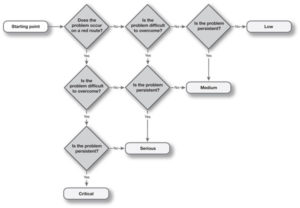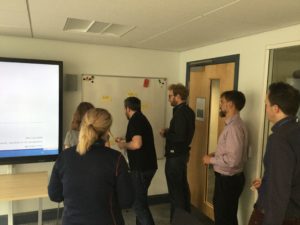Agile, collaborative, influential usability testing – lunchtime meetup write up
In our latest lunchtime meetup, UX Service Manager Neil Allison gave a preview of the talk he presented at UX Scotland. He shared a tried and tested method of bringing teams together to prioritise usability issues effectively.
Usability testing is one of the most valuable techniques there is to improve the digital products we create – or anything we design that people interact with. The UX Service works alongside project teams to conduct usability testing regularly and we want to encourage people that it’s a process that you should conduct repeatedly throughout the life of a project.
Blog posts about usability testing
It is straight forward and extremely beneficial. However, as Neil explained, there are challenges.
The challenges
With reference to Caroline Jarrett and Steve Krug, who surveyed the UX community in 2012 to find out why usability problems go unfixed, Neil explained that it’s not all plain sailing. We face common challenges that include:
- getting the go-ahead to use your time on usability testing
- getting colleagues to take on board what you uncover
- getting fixes to problems implemented
‘More investigation of why usability problems go unfixed’ – Caroline Jarrett
These were challenges that Neil faced back in 2013 when he was the University’s CMS Service Manager during the period the University switched CMS to the open-sourced Drupal-based EdWeb system – a big change that required a bigger team and new methodologies to effectively execute the project on time.
Rocket Surgery Made Easy
With no pre-existing culture of being user-focused in the way projects were run, things needed to change. Neil looked towards the work of Steve Krug, in particular his book Rocket Surgery Made Easy.
Steve Krug’s ‘Rocket Surgery Made Easy: The Do-It-Yourself Guide to Finding and Fixing Usability Problems’ is the ultimate handbook for anybody who wants to start usability testing.
Anyone who’s ever watched a usability test knows that they work remarkably well. Sitting someone down and having them use what you’re building while you watch is the best way to ensure that it will actually be usable. And yet very few organizations do usability tests. And the ones that do don’t do them very often. Why? It’s simple: most people think usability tests are expensive, time consuming and hard to do. But they don’t have to be any of those things. In fact, I wrote Rocket Surgery because I know from years of experience that valuable, effective usability tests can be done quickly and easily, with little or no cost. – Steve Krug
Rocket Surgery Made Easy book information on Steve Krug’s website
Usability testing downloads on Steve Krug’s website
Neil adopted Krug’s approach and began conducting iterative cycles of usability testing. The tests were recorded and the project team would gather to watch the footage. The team would use Steve Krug’s method of individually noting down the top three usability issues they observed after each video.
This was effective and helped bring the team together to collaborate and have constructive conversations about the issues they observed. However, it wasn’t perfect and the sessions would often go off track. Conversations would focus on issues outside of the usability testing footage and the sessions would often end without any real closure or tangible outcomes.
Neil also wanted to bring in the wider user community who were interested in the progress of the project to the sessions. If conversations were not fully productive with 6 people in the room, what would happen with 40? Something needed to change.
David Travis and’Red Route’ usability
Neil told us about David Travis who introduced a means for project teams to talk about usability testing in an effective way. Based on ‘Red Route’ usability, Travis created a way to easily prioritise usability issues in a collaboratively and objectively. This was the method Neil adopted as it allowed the team to grade the usability issues they observed using a three question flow chart.
Important roads in London are known as ‘red routes’ and Transport for London do everything in their power to make sure passenger journeys on these routes are completed as smoothly and quickly as possible. Define the red routes for your website and you’ll be able to identify and eliminate any usability obstacles on the key user journeys. – David Travis
Red route usability: The key user journeys with your web site – David Travis

How to prioritise usability problems – decision tree by David Travis
Download the decision tree as a PDF
By asking the three questions on the chart, every issue is given a severity grading, from low to critical. This method significantly channelled the conversation and allowed the team to stay on target and get the most out of their meetings. It also worked well with larger groups.
Neil’s slides from the session
Take a look at Neil’s slides to learn more as he provides a step-by-step guide on how you can run a collaborative usability testing playback session as well as his own top tips.
The group discussion
As always, the session was a great opportunity to meet, talk to and learn from colleagues. We followed the talks with a discussion based on a group-organised agenda. We used the Lean Coffee approach to decide what to talk about and for how long.

The group vote on which topics to discuss
The topics we chose to discuss in the session included:
- As facilitators, what can we do to stop the group shifting to solutions instead of issues?
- The best approaches to guerrilla testing
Get in touch
If you’d like to find out more or bring the UX Service on board to help you better understand your users, get in touch.
Contact the User Experience Service
More UX meetup sessions
Keep an eye out for the next UX meetup. We would love to see you there.
Write-ups of other sessions we’ve run


4 replies to “Agile, collaborative, influential usability testing – lunchtime meetup write up”